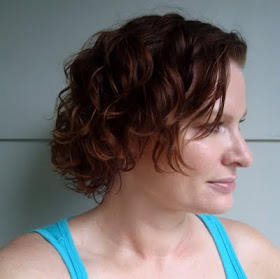 I have two bottles of Rimmel Lasting Finish Pro Polish. I have Midnight Blue and Purple Rain. I'm in love with the color Midnight Blue. It is exactly what I wanted this color to be. It is light enough in color to read navy, and not black, in all lights. But it is not so light in color that it only reads royal blue instead of navy. This is a fine line to walk for dark polishes. The picture of the three nail polishes illustrates this point. The Wet n Wild is royal blue on my nails, the Rimmel is navy in all lights, and the Orly is Navy blue in bright light, but black in most lights (Pic 3). I've added one picture of Midnight Blue on my nails with a regular top coat (Seche Vite, pic 1) and one picture with a matte top coat (Hard Candy Mattle-ly in Love, pic 2). I'm a fan of how this polish looks with both finishes. I think this is a particularly nice color on pale skin.
I have two bottles of Rimmel Lasting Finish Pro Polish. I have Midnight Blue and Purple Rain. I'm in love with the color Midnight Blue. It is exactly what I wanted this color to be. It is light enough in color to read navy, and not black, in all lights. But it is not so light in color that it only reads royal blue instead of navy. This is a fine line to walk for dark polishes. The picture of the three nail polishes illustrates this point. The Wet n Wild is royal blue on my nails, the Rimmel is navy in all lights, and the Orly is Navy blue in bright light, but black in most lights (Pic 3). I've added one picture of Midnight Blue on my nails with a regular top coat (Seche Vite, pic 1) and one picture with a matte top coat (Hard Candy Mattle-ly in Love, pic 2). I'm a fan of how this polish looks with both finishes. I think this is a particularly nice color on pale skin.
I wanted Purple Rain (Pic 4) to be a similar polish, but in a purple. This color was a disappointment. It just skews way too brown for my taste. Midnight Blue makes me feel sophisticated. Purple Rain makes me feel like a 40 year old who is trying to be a disgruntled teen. I know that dark or black polishes are now acceptable for all age groups, but I just didn't like this one on me.

This formula is a winner for me. It wears 5-6 days without any noticeable chips. This is basically my one and only true criteria for judging nail polish. Other then that, it preforms the way you expect nail polish to preform. I'll add my declaimer that nail polishes preform differently on everyone. What works for me may be terrible for you.
See also my post on the Rimmel Lasting Finish Pro color Gold Silk and Rags to Riches.



















